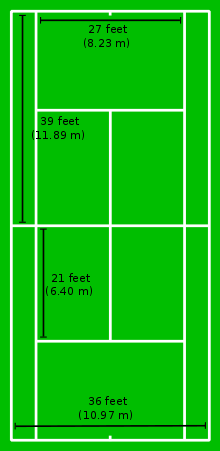the court
The court
Tennis is played on a rectangular, flat surface, usually grass, clay, a hardcourt of concrete and/or asphalt and occasionally carpet (indoor). The court is 78 feet (23.77 m) long, and 27 feet (8.23 m) wide for singles matches and 36 ft (10.97 m) for doubles matches. Additional clear space around the court is required in order for players to reach overrun balls. A net is stretched across the full width of the court, parallel with the baselines, dividing it into two equal ends. The net is 3 feet 6 inches (1.07 m) high at the posts and 3 feet (91.4 cm) high in the center.
The modern tennis court owes its design to Major Walter Clopton Wingfield who, in 1873, patented a court much the same as the current one for his stické tennis (sphairistike). This template was modified in 1875 to the court design that exists today, with markings similar to Wingfield's version, but with the hourglass shape of his court changed to a rectangle.
 The dimensions of a tennis court.
The dimensions of a tennis court.
Lines
The lines that delineate the width of the court are called the baseline (farthest back) and the service line (middle of the court). The short mark in the center of each baseline is referred to as either the hash mark or the center mark. The outermost lines that make up the length are called the doubles sidelines. These are the boundaries used when doubles is being played. The lines to the inside of the doubles sidelines are the singles sidelines and are used as boundaries in singles play. The area between a doubles sideline and the nearest singles sideline is called the doubles alley, which is considered playable in doubles play. The line that runs across the center of a player's side of the court is called the service line because the serve must be delivered into the area between the service line and the net on the receiving side. Despite its name, this is not where a player legally stands when making a serve. The line dividing the service line in two is called the center line or center service line. The boxes this center line creates are called the service boxes; depending on a player's position, he will have to hit the ball into one of these when serving. A ball is out only if none of it has hit the line or the area inside the lines upon its first bounce. All the lines are required to be between 1 and 2 inches (51 mm) in width. The baseline can be up to 4 inches (100 mm) wide if so desire.